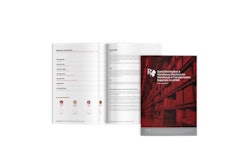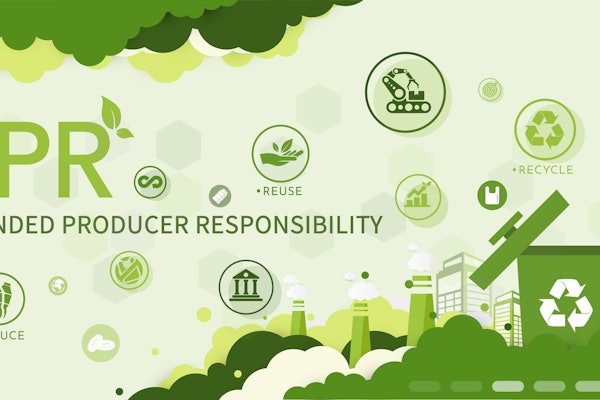At the ISTA Forum’s TempPack in Houston (May 1-3, 2023), Lee Menszak, associate director, engineering at Merck, shared tips and considerations for qualifying pallet-sized shippers, where the risk is often much greater than that of a small parcel-sized shipper.
“Large shippers are different than small shippers for a variety of reasons. The ones that I would point out the most are that the payloads are larger, they are expensive, and they would be difficult and time-consuming to replace. So it's important that you get it right the first time, and that you have a robust solution,” said Menszak.
He also highlighted that large shippers have longer pack-out durations, larger temperature gradients within the payload space, and a greater number of closure points during assembly, among other factors.
1. Don't ignore regional user requirements (including safety)
Menszak showed attendees a picture in which an operator is inside the shipper loading dry ice while wearing a full backpack respirator. “The reason is in the Netherlands, it is a requirement you must do this. You need to know the specifics of the individual country. Don’t think about your perspective from your desk when you’re qualifying the shipper,” he said, adding that you must consider safety during loading, as dry ice is regulated as a dangerous good. IATA PI 954 requires specific labeling and adequate ventilation so that pressure build-up doesn't rupture the packaging.
For more on logistics and supply chain, check out the new Logistics Pavilion at PACK EXPO Las Vegas, taking place September 11-13, 2023. To register, visit packexpolasvegas.com
2. Thou shalt know thy shipper
“My number one rule of qualification is ‘Thou shalt know thy shipper,’” he said. “When you get done with the qualification, you should know it as well as—or better—than the manufacturer, you need to become the SME. The earlier you do it the better.”
If the space for dry ice in the shipper is 2.75 inches, you can’t load a 3.5-inch block of dry ice. If the dry ice block is 1.5 inches, it will rattle and won’t fill the space. He added, “My question to you is what good is qualification if when you give it to a user site, the dry ice they have available isn’t going to work?”
3. TOCS is a user requirement
Time out of controlled storage (TOCS) is the time to go from where the product is stored to where it’s packed out. Prior to the pack out, it’s expected to have a delay while preparing the payload for loading, with time for quality checks, securing the payload onto the pallet with banding or strapping, and other routine operational handling requirements.
TOCS must be controlled and minimized, but it also needs to be quantified and be representative of what is needed. “It is for the user to define, so you need to talk to those responsible for doing the packout,” he noted.
Menszak said he has found TOCS is typically 30 minutes but encountered one site that needed one hour from removal from -40°C to the shipper door close. This user requirement specification needs to be included in the qualification testing, so it’s important to let your qualification lab know.
Max Load and Worst Case
“What’s the worst case? In my experience—not to be taken as law—max load, max mass is the worst case. I have seen it the opposite way where dry ice sublimates, CO2 gas sinks, and the hot air rises. Unlike small shippers, convection dominates here [in pallet-sized shippers]. You need to test to find out what your worst-case scenario is.”
—Lee Menszak
4. Rationale is a neglected area
As he explained, “It's one thing to say that you're going to use this profile or this configuration, but the rationalities need to be included. Why? For the benefit of the approvers, they need to understand why you're doing what you're doing. There's a better reason, though, to be honest. Two, three years down the road when you get audited on the shippers you may have forgotten.”
Also, it may be another person presenting your protocol who is in the dark about why you did what you did. Documenting the rationale will clarify why you made those choices—whether it’s you or another person in the audit.
Some parameters may be obvious for inclusion in your rationale such as ambient profile, duration, payload and thermal mass, and refrigerant loading. But there are other activities to consider, which may actually precede qualification such as CO2 sensitivity, cyro temperature tolerance, container closure integrity, and re-icing. “Dry ice sublimates… CO2 gas doesn't know it is not allowed to interact with the product. If you’re using dry ice, you need to have a CO2 sensitivity test in advance of qualification concluding that CO2 ingress is not an issue with your product,” Menszak said. Additionally, plastics, tubing, and clamps can be sensitive to cracking at low temperatures, so testing primary packaging early on is critical.
5. Test for shipper-to-shipper variation
While it’s not a requirement, Menszak highly advocates you test shipper-to-shipper variability. If you fly a fleet of a dozen hardshell shippers, how do you know that they are all performing equally?
While the vendor provides an analysis, the only way to find out is to actually test. “And it's a simple test. Load them up with dry ice, put the temperature monitors in at minimum load, and you let them run. It doesn't require a laboratory; it can be in the warehouse. At the end of testing, you may, as I have, find one that's an underperformer. So from Day One, you have a troublesome shipper. Here's your justification. Go back to the vendor and say this one's bad, we need a replacement. And they also know they better give you a good one back because you're going to test it to find out,” he said.
He explained there’s another good reason for doing this test: when years go by, suddenly you get a shipment that didn't go as expected, without a good explanation. “You can repeat this test. So you can test shipper #4 that's a problem today and compare the results and how it performed when it was brand new,” Menszak said. “There may be degradation. What is the life expectancy of the shipper? My experience is that the manufacturers will give you a vague answer because it depends on the usage, the number of turns. So it's a good way, five years down the road to say, ‘We're starting to see some problems. Let's run through the same test we did when they were new and see what's going on.’” This can help you determine if you’ll need to replace certain shippers.
This test is also beneficial for evaluating cool down time, i.e. how long does it take the shipper to cool down after you load the dry ice? Following the loading of the payload into the shipper, one can expect that there will be a cool down time where the product temperature will exceed the allowable storage and shipping temperature. Whether or not this is acceptable depends on your stability data, hence why stability data is a predecessor to performing shipping qualification.
Cool down time is important information to include in the qualification, and it’s important to the user. He shared an example showing that a shipper took approximately two hours to arrive at -40°C. “The user, for example, loaded the shipper in the morning at 8am. And the question is ‘When can I load the product?’ This tells you your spec. You load it, you wait two hours. From 10am up to 2pm is your window of opportunity. You would qualify for the worst case which would be a six-hour delay before loading the product," he said. "Inevitably you get the question, 'Can I use it the next day since we didn’t get to load it today?' My answer is ‘No.’ The reason being that you're then sacrificing shipper duration. You're losing what we're setting out to achieve: maximum duration. So my answer is to start all over. Empty it out and load the dry ice again the next day.”
Related reading: What’s Next in Transit Packaging Research and Guidance?























